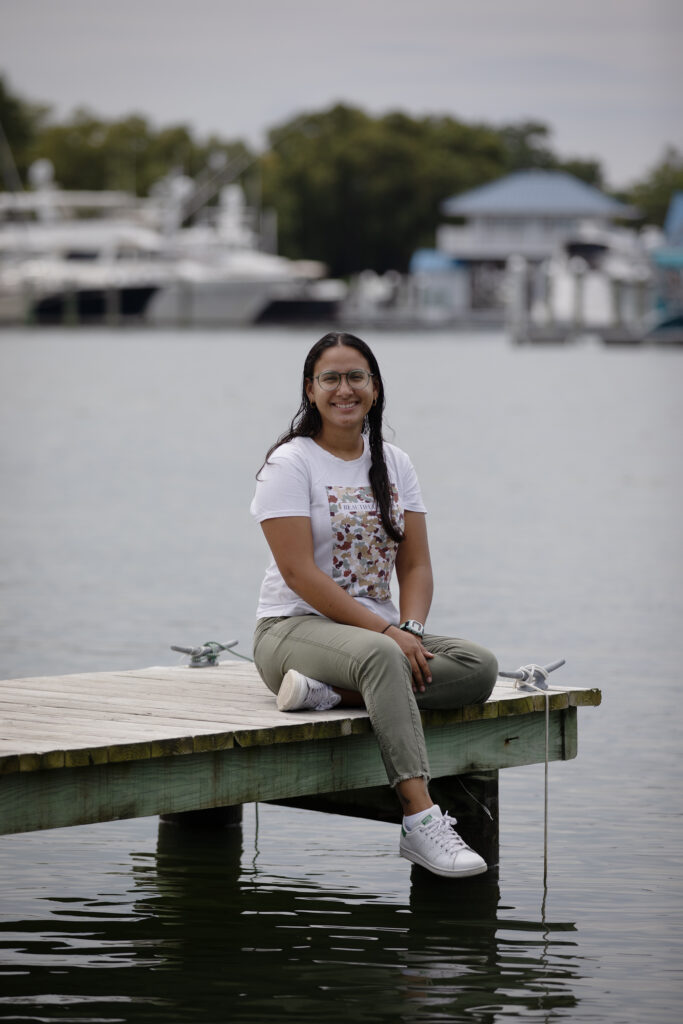
What is a NERTO?
The NOAA LMRCSC-II offers training and professional development to students through coursework, seminars, and workshops, and provides support for internships, including the NOAA Experiential Research and Training Opportunity (NERTO), to prepare students for careers aligned with the NOAA mission. The Center’s training is conducted collaboratively with NOAA scientists at the NOAA Science Centers and Laboratories, which ensures LMRCSC research stays relevant to NOAA needs, strengthens partnerships with NOAA, introduces fellows to the structure and function of NOAA.
Graduate fellows supported by the LMRCSC-II are required to have a NOAA scientist serve on their advisory committees. They are also required to participate in a NERTO–a 12-week internship at a NOAA lab or facility under the supervision of a NOAA mentor scientist.
During the summer of 2023, seven EPP/MSI LMRCSC fellows completed internships at NOAA facilities, fulfilling their NERTO requirement. These aspiring scientists were immersed in hands-on experiences and worked side-by-side with seasoned professionals to advance our understanding of the marine environment.
One such fellow, Lucia Ramirez-Joseph, traveled from the mid-Atlantic to the Caribbean, then up to New England for her NERTO internship this summer. A Master’s fellow pursuing a biology degree from Hampton University in Virginia, Lucia furthered her thesis research by focusing on shellfish.
Internship Opens Opportunities for Puerto Rico Native
During the school year, Lucia works alongside her academic advisor, Dr. Joseph Reustle, and undergraduate fellow T’Kiyah Reeves, focusing on oyster reef restoration along the Hampton River. With her restoration work, Lucia hopes to apply her knowledge to the declining coastal ecosystems in Puerto Rico, where she grew up.
Because of her work with oysters, Lucia was familiar with NOAA’s National Shellfish Initiative, which aims to increase populations of bivalve shellfish in our nation’s coastal waters through sustainable commercial production and restoration efforts. Eight U.S. states and the Gulf of Mexico adopted the initiative.
However, since there are no prescribed benchmarks for adopters, it was difficult to measure the initiative’s progress. Lucia’s NERTO aimed to solve that. She investigated who in the state had taken ownership of the initiative and interviewed them about achievements and roadblocks they encountered.
When Lucia’s NOAA advisor, Aquaculture Coordinator for the Greater Atlantic Region Kevin Madley, learned Lucia was from Puerto Rico, he suggested she travel there and investigate the potential for starting an oyster restoration project.
Lucia went to her home island for two weeks, working with Dr. Megan Davis of Florida Atlantic University to observe her queen conch restoration efforts and take notes. She then traveled to NOAA Northeast Fisheries Woods Hole Laboratory, south of Boston, to meet NOAA scientists, tour the facilities and network with other interns.
Lucia’s NERTO will culminate in a white paper for NOAA, outlining results of the shellfish initiative from each of its adopters. She will also offer suggestions for future steps, such as how to include Puerto Rico in the initiative and identifying potential funding sources for adopters.
NERTO Results
Since 2016, sixty-seven (67) NOAA EPP/MSI LMRCSC graduate students have taken part in NERTOs at the NOAA Northeast Fisheries Science Center, NEFSC (15); Southeast Fisheries Science Center, SEFSC (12); Northwest Fisheries Science Center, NWFSC (10); NOAA Ocean Service, NOS (7); NOAA Chesapeake Bay Office, CBO (5); Southwest Fisheries Science Center, SWFSC (5), and Alaska Fisheries Science Center, AFSC (4). Other laboratories/facilities where students conducted NERTO are the Pacific Island Fisheries Science Center, PIFSC; Greater Atlantic Regional Fisheries Office (GARFO), Southeast Regional Office (SERO), and Pacific Marine Environmental Lab (PMEL).
Planning for NERTO begins with introduction of students to NOAA scientists working in their research area of interest. Most students use their NERTO projects as a part of their thesis or dissertation research.
Research projects conducted by the students are diverse and aligned with NOAA Fisheries priorities, and their results have increased the body of knowledge related to fish stocks and their habitats, and fisheries management.
Some projects focused on commercially important finfish species such as Black Sea Bass (Centropristis striata), King mackerel (Scomberomorus cavalla), Pacific Cod (Gadus macrocephalus), American Plaice (Hippoglossoides platessoides), Striped Bass (Morones saxatilis) and Pacific Salmon. Others contributed to knowledge of shellfish (e.g., Dungeness crab, blue crabs, oysters) ecology, pathology and pathogens, or protected species, including Antarctic fur seals (Arctocephalus gazelle), Kemp’s Ridley Sea turtle (Lepidochelys kempii), Common Bottlenose Dolphins, leopard and fur seals, Hawaiian monk seal (Monachus schauinslandi), and sturgeon. Some students developed marine food web models, essential fish habitat maps, or species distribution models for groundfish.
Center students have presented results of their NERTO research at the NOAA Science Seminar series.
Results of surveys administered to interns at the end of the internship program indicate that it was beneficial to the students. Over 53.4% of NERTO participants stated that they generated new data for models or products for NOAA host office. They acquired valuable experiences during NERTO, and incorporated skills gained from the training in their theses and dissertations. Graduate fellows (67.2%) demonstrated new/expanded competencies to conduct research and engage in NOAA mission-aligned activities.


